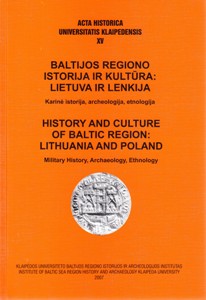Volume 15 (2007): Baltijos regiono istorija ir kultūra: Lietuva ir Lenkija. Karinė istorija, archeologija, etnologija = History and Culture of Baltic Region: Lithuania and Poland. Military History, Archaeology, Ethnology, December 2007

Order by:
Pub. online: 10 Dec 2007
Type: Introduction
 Open Access
Open Access
Journal:
Acta Historica Universitatis Klaipedensis
Volume 15 (2007): Baltijos regiono istorija ir kultūra: Lietuva ir Lenkija. Karinė istorija, archeologija, etnologija = History and Culture of Baltic Region: Lithuania and Poland. Military History, Archaeology, Ethnology, pp. 5–9
Pub. online: 10 Dec 2007
Type: Article
 Open Access
Open Access
Journal:
Acta Historica Universitatis Klaipedensis
Volume 15 (2007): Baltijos regiono istorija ir kultūra: Lietuva ir Lenkija. Karinė istorija, archeologija, etnologija = History and Culture of Baltic Region: Lithuania and Poland. Military History, Archaeology, Ethnology, pp. 9–24
Abstract
Pub. online: 9 Dec 2007
Type: Article
 Open Access
Open Access
Journal:
Acta Historica Universitatis Klaipedensis
Volume 15 (2007): Baltijos regiono istorija ir kultūra: Lietuva ir Lenkija. Karinė istorija, archeologija, etnologija = History and Culture of Baltic Region: Lithuania and Poland. Military History, Archaeology, Ethnology, pp. 25–34
Abstract
Pub. online: 10 Dec 2007
Type: Article
 Open Access
Open Access
Journal:
Acta Historica Universitatis Klaipedensis
Volume 15 (2007): Baltijos regiono istorija ir kultūra: Lietuva ir Lenkija. Karinė istorija, archeologija, etnologija = History and Culture of Baltic Region: Lithuania and Poland. Military History, Archaeology, Ethnology, pp. 25–40
Abstract
Pub. online: 9 Dec 2007
Type: Article
 Open Access
Open Access
Journal:
Acta Historica Universitatis Klaipedensis
Volume 15 (2007): Baltijos regiono istorija ir kultūra: Lietuva ir Lenkija. Karinė istorija, archeologija, etnologija = History and Culture of Baltic Region: Lithuania and Poland. Military History, Archaeology, Ethnology, pp. 35–43
Abstract
Pub. online: 10 Dec 2007
Type: Article
 Open Access
Open Access
Journal:
Acta Historica Universitatis Klaipedensis
Volume 15 (2007): Baltijos regiono istorija ir kultūra: Lietuva ir Lenkija. Karinė istorija, archeologija, etnologija = History and Culture of Baltic Region: Lithuania and Poland. Military History, Archaeology, Ethnology, pp. 41–56
Abstract
Pub. online: 9 Dec 2007
Type: Article
 Open Access
Open Access
Journal:
Acta Historica Universitatis Klaipedensis
Volume 15 (2007): Baltijos regiono istorija ir kultūra: Lietuva ir Lenkija. Karinė istorija, archeologija, etnologija = History and Culture of Baltic Region: Lithuania and Poland. Military History, Archaeology, Ethnology, pp. 45–54
Abstract
Pub. online: 9 Dec 2007
Type: Article
 Open Access
Open Access
Journal:
Acta Historica Universitatis Klaipedensis
Volume 15 (2007): Baltijos regiono istorija ir kultūra: Lietuva ir Lenkija. Karinė istorija, archeologija, etnologija = History and Culture of Baltic Region: Lithuania and Poland. Military History, Archaeology, Ethnology, pp. 55–69
Abstract
Pub. online: 10 Dec 2007
Type: Article
 Open Access
Open Access
Journal:
Acta Historica Universitatis Klaipedensis
Volume 15 (2007): Baltijos regiono istorija ir kultūra: Lietuva ir Lenkija. Karinė istorija, archeologija, etnologija = History and Culture of Baltic Region: Lithuania and Poland. Military History, Archaeology, Ethnology, pp. 67–78
Abstract
Pub. online: 9 Dec 2007
Type: Article
 Open Access
Open Access
Journal:
Acta Historica Universitatis Klaipedensis
Volume 15 (2007): Baltijos regiono istorija ir kultūra: Lietuva ir Lenkija. Karinė istorija, archeologija, etnologija = History and Culture of Baltic Region: Lithuania and Poland. Military History, Archaeology, Ethnology, pp. 71–85
Abstract